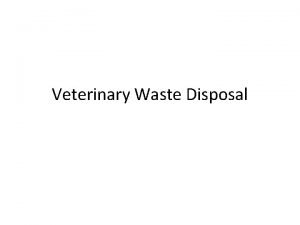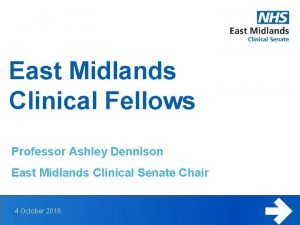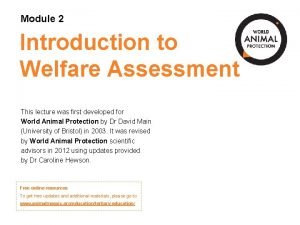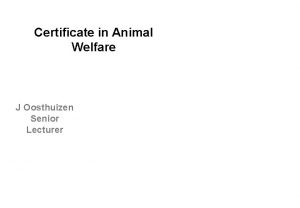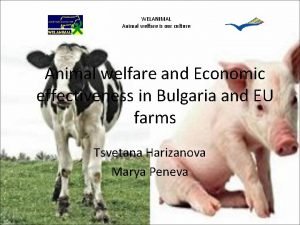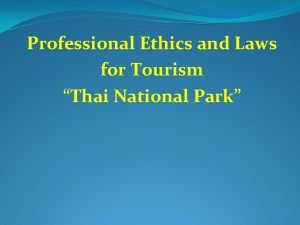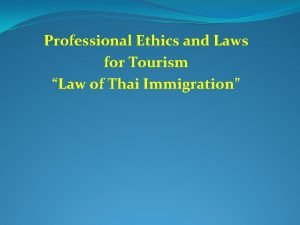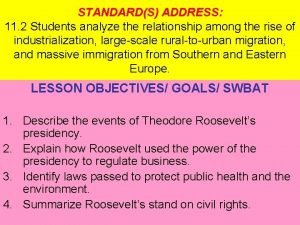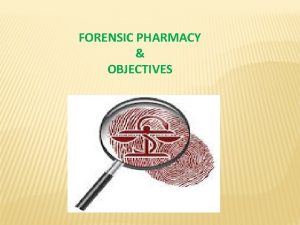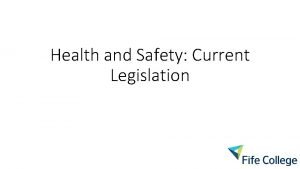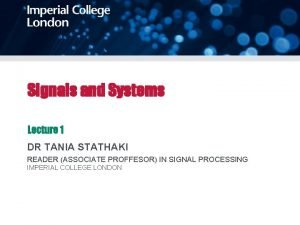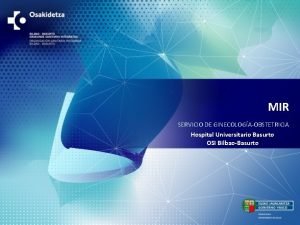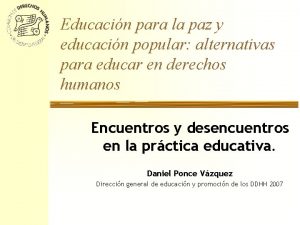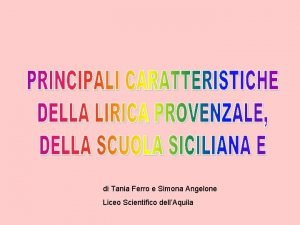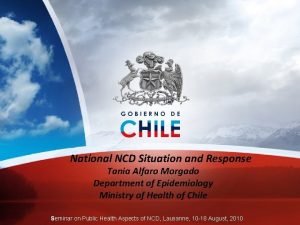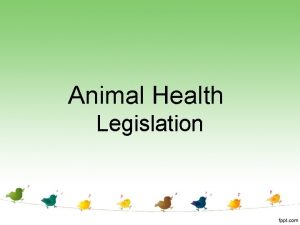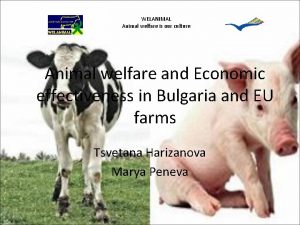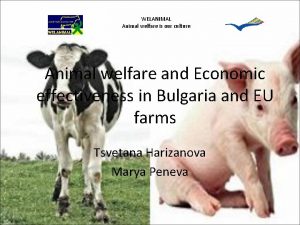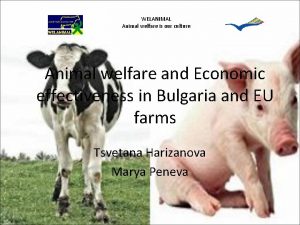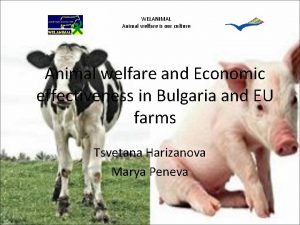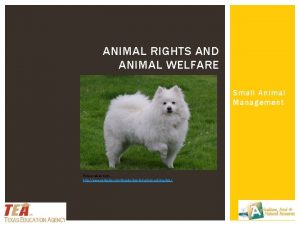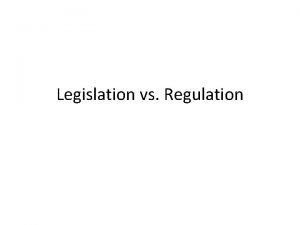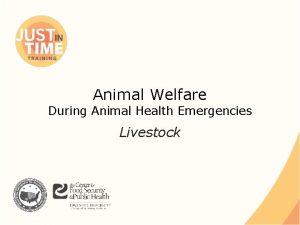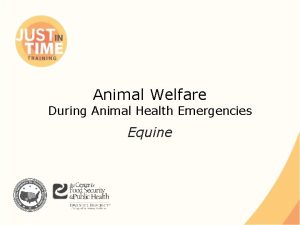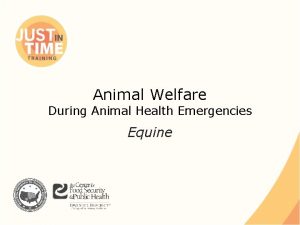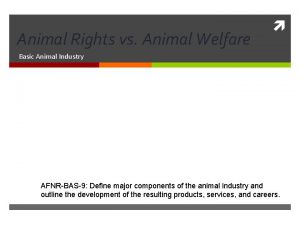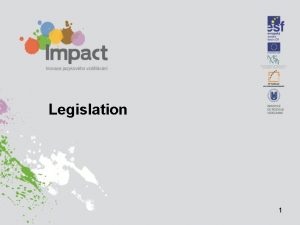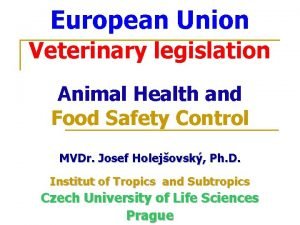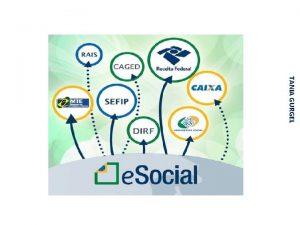Veterinary Legislation and Animal Welfare Tania Dennison and


























- Slides: 26

Veterinary Legislation and Animal Welfare Tania Dennison and David M. Sherman

Objectives of the Presentation • Part 1 – Brief background on the OIE Veterinary Legislative Support Program (VLSP) in the context of the OIE PVS pathway • Part 2 – Identify the role of veterinarians in animal welfare – Identify animal welfare sections of the Terrestrial Code – Identify key elements and resources in drafting animal welfare legislation

OIE support to improve welfare legislation • • OIE World Fund Performance of Veterinary Services (PVS) Pathway Veterinary Legislative Support Programme (VLSP) OIE recommendations in the Terrestrial Code

OIE World Fund • Established in 2004 • Objectives include: – Improving governance of animal health systems, including veterinary services and their compliance with OIE standards on quality via the OIE PVS Pathway – Modernising existing national veterinary legislation • World Fund resources are used to implement the – Performance of Veterinary Services (PVS) Pathway – Veterinary Legislative Support Programme (VLSP)

The PVS Pathway – what is it? • Global programme for the sustainable improvement of a country's Veterinary Services' compliance with OIE standards on the quality of Veterinary Services. • Important foundation for improving animal and public health and enhancing compliance with SPS standards, at the national, regional and international level.

The PVS Pathway –how does it work? 1. Members request an expert mission 2. OIE send a team of experts to conduct an objective, standardized, systematic evaluation of 46 critical competencies within the Members’ overall veterinary services. 3. PVS evaluation report identifies strengths and weaknesses in the veterinary services 4. Report serves as a guide for decision making: § setting priorities and allocating resources to improve veterinary services § the basis for additional OIE missions, e. g. , PVS gap analysis or legislative identification mission.

The PVS Pathway OIE PVS Pathway for efficient Veterinary Services Evaluation PVS « diagnosis » PVS Gap Analysis « prescription» OIE collaborates with governments, stakeholders and donors (if needed) « treatment » Veterinary Services Strategic Plan Modernisation of legislation Public/private Partnerships Country / Donors Investment / Projects Veterinary Education Laboratories 7 PVS Follow-Up Evaluation mission

OIE PVS Evaluation Missions (State of play through 13 September 2012) OIE Regions Africa Americas Asia & Pacific Europe Middle East Total PVS OIE Requests Missions Members received done 52 51 47 29 32 53 12 178 22 18 15 12 118 21 18 14 11 111 8

The Importance of Veterinary Legislation

Importance of Veterinary Legislation • Essential element of the national infrastructure. • Provides the legal basis, powers and authorities for Veterinary Services to efficiently carry out their key functions including: – epidemio-surveillance; – early detection and reporting of diseases, including zoonoses; – rapid response to and prevention and control of sanitary emergencies; – food safety; – animal welfare; – relevant certification of animals and animal products for export.

Importance of Veterinary Legislation • This is why the development and efficient implementation of legislation is included among the 46 critical competencies identified in the OIE PVS Tool for the Evaluation of Performance of Veterinary Services.

Veterinary Legislation Support Programme

History of the VLSP • PVS evaluations revealed that, in many cases, veterinary legislation is outdated and inadequate to meet current and future challenges and societal expectations. • In 2009, at Members request, the OIE developed Guidelines on Veterinary Legislation, identifying the essential elements that should be covered by legislation to meet the OIE standards. • In December 2010, the first OIE Global Conference on Veterinary Legislation was held in Djerba (Tunisia).

History of the VLSP • A recommendation of the Conference was that the OIE propose the adoption and publication of the current Veterinary Legislation Guidelines as standards in the Terrestrial Code • In response to this recommendation, OIE convened an ad hoc Group on Veterinary Legislation to develop the draft chapter. • The draft chapter on veterinary legislation was unanimously adopted by the World Assembly of Delegates at the 80 th OIE General Session in May 2012. • It is now Chapter 3. 4 of the Terrestrial Code

Services of the VLSP • As a follow up to an evaluation of the Performance of Veterinary Services (PVS) using the OIE PVS Tool, and at the request of Members, the OIE conducts missions to help governments that wish to modernise the national veterinary legislation and thereby help the veterinary services to meet the OIE standards. • After an initial ‘identification’ mission the country may request a longer term collaboration with the OIE, under a formal agreement, with the objective of modernising the national veterinary legislation. • As with other elements of the OIE PVS Pathway, legislation missions are undertaken by experts who are trained and certified by the OIE for this purpose. Mission reports are confidential unless/until the country authorises release to Donors or other OIE partners.

Veterinary Legislative Identification Missions Objectives: to clarify the situation in the country and analyse its needs relative to veterinary legislation. 1. Preparatory phase before the mission. It involves completion phase of questionnaires to provide the team with advance information on the fundamental characteristics of the legal system and the current laws. 2. One week visit by the mission team (usually 2 persons) – 3 steps: Step 1 – OIE concepts and tools used by the Team are presented at incountry discussions and the current situation is reviewed. Step 2 – Review of legislation and questionnaires to determine coverage of the veterinary domain. Step 3 – Assessment of needs and approaches to addressing them. 3. Follow up report with recommendations on legislative reform report and further actions for approval and acceptance by Member.

Veterinary Legislation Identification Missions (through 13 th Sept 2012) OIE Members Mission requests received Mission Done Report Finalised Africa 52 22 15 15 Americas 29 5 3 3 Asia + Pacific 32 5 4 4 Europe 53 3 2 2 Middle East 12 4 4 4 TOTAL 178 39 28 28

Veterinary Legislation and Animal Welfare

Role of Veterinarians in Animal Welfare • Society recognizes the important role of veterinarians, based on their training and professional activities, in relation to both animal health and welfare. • Freedom from disease is an essential element for ensuring animal welfare. Sick animals suffer. • OIE continues to highlight the responsibility of the veterinary profession for improving animal health and welfare globally. • At the national level, the veterinary profession must be actively involved in the drafting, implementation and enforcement of laws on animal welfare. • Veterinary involvement is required to ensure that provisions relating to animal welfare founded on scientific principles, not on emotional considerations.

Aspects of Animal Welfare Covered in Section 7 of the Terrestrial Code • • • Guiding principles for animal welfare The transport of animals by land The transport of animals by sea The transport of animals by air The slaughter of animals for human consumption The killing of animals for disease control purposes The control of stray dog populations The use of animals in research and education Animal welfare and beef cattle productions systems

Legislation and the terrestrial code • Veterinary legislation on animal welfare should be consistent with the recommendations of the Terrestrial Code • Members may choose to include other animal welfare issues in their legislation, e. g. , – Sale and breeding of companion animals – Welfare of working animals – Treatment of animals used in sport – Capture of wild animals – Well being of animals kept in zoos

Important Considerations for Drafting Animal Welfare Legislation • Wide consultation during development is essential • Ensure as many stakeholders as possible are involved • You should identify: – Types of animals the legislation applies to – Competent authority for enforcement of animal welfare legislation – Appropriate personnel to whom powers of enforcement are given, i. e. , veterinary inspectors or others, and their powers – Mechanism for exacting penalties – e. g. , it may be included in the penal code

Ensuring Harmonisation • Harmonize animal welfare legislation with: – Local legislation, e. g. environmental laws, veterinary medicine laws, public health laws – Legislation of regional neighbours – Legislation of trading partners – Other relevant international legislation, treaties, conventions, guidelines (e. g. IATA, CITES) To ensure consistency of humane treatment of animals during transport and other procedures.

Conclusions • Animal welfare is a responsibility of the veterinary profession. • Animal welfare is growing as a consideration for international trade in animals. • Veterinary legislation must include provisions to protect animal welfare and these provisions must be science based. • The OIE provides support and guidance to Members in drafting veterinary legislation, including animal welfare legislation, through the OIE Veterinary Legislative Support Programme.

Sources of additional information • http: //www. oie. int/support-to-oie-members/veterinarylegislation/ (OIE web page on legislation) • http: //www. oie. int/animal-welfare-keythemes/ (OIE web page on welfare) • http: //www. fao. org/ag/againfo/themes/animal-welfare/awresources/en/ (FAO gateway) • http: //awic. nal. usda. gov/government-and-professionalresources/international (USDA Animal Welfare Information Centre) • http: //www. animallaw. info/ (Animal Legal and Historical Centre)

Thank you
 Tania dennison
Tania dennison Veterinary waste
Veterinary waste Plant vs animal cells venn diagram
Plant vs animal cells venn diagram Similarities between animal rights and animal welfare
Similarities between animal rights and animal welfare Venn diagram of plant and animal cells
Venn diagram of plant and animal cells Paul dennison
Paul dennison East midlands clinical senate
East midlands clinical senate Module 2 the animal world
Module 2 the animal world Higher certificate in animal welfare
Higher certificate in animal welfare Welpets
Welpets National policy and legislation
National policy and legislation Tourism legislation and professinal ethics
Tourism legislation and professinal ethics Thailand former name
Thailand former name Summarize roosevelt's approach to environmental problems
Summarize roosevelt's approach to environmental problems Ict ethics and legislation
Ict ethics and legislation Forensic pharmacist
Forensic pharmacist Health and safety legislation
Health and safety legislation Tania stathaki
Tania stathaki Edificio gobierno hospital basurto
Edificio gobierno hospital basurto Tania mattiuzzo psicologa
Tania mattiuzzo psicologa Educacion popular
Educacion popular Cecilia poletto ricevimento
Cecilia poletto ricevimento Fanau ola
Fanau ola Dr tania brasse
Dr tania brasse Liceo scientifico ferro
Liceo scientifico ferro Tania alfaro
Tania alfaro Tania leblond
Tania leblond

